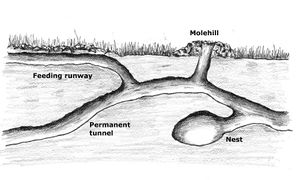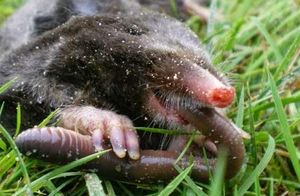Moles

Moles are subterranean macro-fauna that belong to the family Talpidae. They are often considered pests due to their burrowing habits, which can disturb soil and (indirectly) damage plants, but this can be beneficial as well. Due to these habits, moles can be considered ecosystem engineers. There are seven identified species of mole in North America: the Eastern Mole (Scalopus aquaticus), the Hairy-Tailed Mole (Parascalops breweri), the Star-Nosed Mole (Condylura cristata), the Broad-Footed Mole (Scapanus latimanus), Townsend’s Mole (Scapanus townsendii), the Coast Mole (Scapanus orarius) and the Shrew Mole (Neurotrichus gibbsii) [8].
Taxonomy
| Domain | Kingdom | Phylum | Class | Order | Family | |
|---|---|---|---|---|---|---|
| Classification | Eukaroyta | Animalia | Cordata | Mammalia | Insectivora | Talpidae |
This simplified list omits sub-categories. Moles may be confused as rodents (Order Rodentia) but this is incorrect.
Description
Moles are typically 17.6 cm in length and 115 g in mass for males and 16.8 cm and 85 g for females. Other than these measurement differences, sexual dimorphism is minimal [1]. Males are called "boars" and females are called "sows", similar to bovines [2]. They are well-suited to subterranean lifestyles, often having long but narrow snouts of approximately 1.3 cm for hunting in their tunnels and large forelimbs to carve tunnels through the earth. Moles have on their noses Eimer's organs, which are sensory in nature and used to detect prey below the surface [3]. They prefer loose, moist, earthworm-abundant soils, typically in forested areas [1]. However, they are also often found in grasslands, meadows, and lawns [4]. Their eyes and ears are small and covered completely by fur, with no external flaps for the latter. They have forefeet that are broader than they are long, with webbed toes. Their hind feet are smaller, narrow, and clawed [1]. They are found throughout North America and Eurasia [4].
Lifestyle

Moles are generally solitary, with the exception of the star-nosed mole, which lives in colonies. They live in dens, but construct networks of tunnels through their hunting grounds [1]. Reproduction occurs in late winter, with gestation taking 42 days [2]. Typically, a female has three to four young annually, which stay in the nest for about four weeks, after which they leave and become full sized by around three months. These nests are in the deep tunnels dug out by moles; the shallower ones that are usually visible are hunting tunnels. The typical mole lives for approximately three to six years, taking into account predation [5].
Moles are able to breathe in their cramped tunnels with blood adapted to have greater carbon dioxide capacities, allowing the mole to utilize and process air it has already used [6]. This remarkable adaptation allows moles to remain underground without suffocating. Even though their tunnels aerate the soil, this adaptation is necessary for the mole, which requires great energy (and therefore aerobic respiration) to live its subterranean life.
Moles live almost exclusively underground and are observed to only return to the surface when reaching maturity to find their own home and living environment. Moles are extremally territorial and have been known to cross waterways and other environmental barriers to return to their homes. This tunneling and underground transformation allows for soil aeration due to the tunnels and provide drainage [10]. This tunneling also induces mixture of soil layers encouraging biological activity under the surface.
Diet

Moles are insectivores that hunt below the surface. Generally, moles feast upon insects, slugs, grubs, and earthworms [2]. However they are observed to eat grasses in less favorable conditions. The consumption of grubs is an often-overlooked benefit of moles, but their consumption of earthworms is detrimental due to the plethora of benefits earthworms provide for soils. Moles can poison earthworms with their saliva, resulting in paralyzation, and then store them for later feasting. Moles have also been known to eat small mice [4]. Contrary to popular belief, moles do not feed on plant roots. This is done by rodents, for which moles are often mistaken.
Impact on Other Organisms
Moles are traditionally considered pests by humans, causing destruction to lawns, gardens, and farms, but moles can be beneficial for an area's soil. Mole tunneling results in lawn aeration. Moles are responsible for controlling grub populations [7]. Nevertheless, moles are still usually considered undesirable due to their mole hills and mole runs, which are often considered undesirable in one's lawn [2]. These are both composed of disturbed dirt caused by burrowing. Due to their generally unwanted status, humans have developed a variety of ways to discourage, trap, or kill moles, with some methods being more effective than others [4]. Many of these mitigation efforts can be done without pesticides with these efforts varying from bubble gum to castor oil. These efforts have not been recognized as effective methods from the EPA environmentally with the only recognized repellant being plant based castor oil efforts. Moles are also prey to some mammals, birds, and reptiles while above ground. When underground, some may be accidentally killed by gardeners digging into their burrows [8]. These predators and impact on human life have exclusively led to a majority of a moles life living underground for protection.
Mole activity is a sign of healthy soils. Because moles prefer loamy, rich soils that harbor their prey. Due to their tunnels being major sources of soul aeration, and utilization by other species, moles are considered ecosystem engineers, and unless they are damaging the appearance of land in a way deemed unacceptable, leaving them be is usually beneficial [5].
Moles mainly eat earthworms and live in areas with moist loamy soils and can help mitigate the invasive behavior of invasive species of earthworms due to their diet. This increases biodiversity and increases foliage on the soil floor due to the lack of earthworms.
References
[1] F. Robert Henderson. "Moles". Internet Center for Wildlife Damage Management. 2005. Retrieved 2018-04-16. http://icwdm.org/handbook/mammals/Moles.asp
[2] "Facts About Moles". Havahart. http://www.havahart.com/mole-facts
[3] "Moles, Shrew Moles, And Desmans (Talpidae)". Grzimek's Animal Life Encyclopedia. Encyclopedia.com. Retrieved 2018-04-19. https://www.encyclopedia.com/environment/encyclopedias-almanacs-transcripts-and-maps/moles-shrew-moles-and-desmans-talpidae
[4] "How to get rid of moles". Exterminate.com. Retrieved 2018-04-19. http://www.extermine.com/moles.html
[5] "Eastern Mole". University of Illinois. Retrieved 2018-05-09. https://m.extension.illinois.edu/wildlife/directory_show.cfm?species=mole
[6] Campbell, Kevin, McIntyre, I. and MacArthur, R. 1999.Fasting metabolism and thermoregulatory competence of the star-nosed mole, Condylura cristata (Talpidae: Condylurinae) Comparative Biochemistry and Physiology Part A: Molecular & Integrative Physiology.123. 3. 293-298.
[7] "Moles 'Can Benefit Gardeners'. Hartley Botanic. July 17, 2012. Retrieved 2018-04-16. https://hartley-botanic.com/magazine/801409421-moles-can-benefit-gardeners/
[8] Musser, Guy. 2018. Mole. https://www.britannica.com/animal/mole-mammal
[9] Mole. https://imgur.com/gallery/lufu2
[10] COX, C. (2004). Managing mole problems without Pesticides. Journal of pesticide reform, 24(2), 6-7.